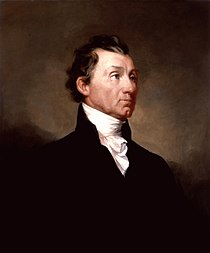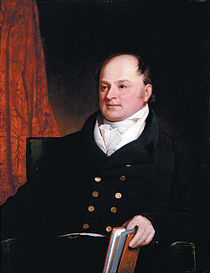
Back Monroeleer Afrikaans مبدأ مونرو Arabic Monro doktrinası Azerbaijani Дактрына Манро Byelorussian Доктрина „Монро“ Bulgarian মনরো নীতি Bengali/Bangla Monroeova doktrina BS Монрогой доктрина BXR Doctrina Monroe Catalan Monroeova doktrína Czech
The Monroe Doctrine is a United States foreign policy position that opposes European colonialism in the Western Hemisphere. It holds that any intervention in the political affairs of the Americas by foreign powers is a potentially hostile act against the United States.[1] The doctrine was central to American grand strategy in the 20th century.[2]
President James Monroe first articulated the doctrine on December 2, 1823, during his seventh annual State of the Union Address to Congress (though it would not be named after him until 1850).[3] At the time, nearly all Spanish colonies in the Americas had either achieved or were close to independence. Monroe asserted that the New World and the Old World were to remain distinctly separate spheres of influence,[4] and thus further efforts by European powers to control or influence sovereign states in the region would be viewed as a threat to U.S. security.[5][6] In turn, the United States would recognize and not interfere with existing European colonies nor meddle in the internal affairs of European countries.
Because the U.S. lacked both a credible navy and army at the time of the doctrine's proclamation, it was largely disregarded by the colonial powers. While it was successfully enforced in part by the United Kingdom, who used it as an opportunity to enforce its own Pax Britannica policy, the doctrine was still broken several times over the course of the 19th century. By the turn of the 20th century, however, the United States itself was able to successfully enforce the doctrine, and it became seen as a defining moment in the foreign policy of the United States and one of its longest-standing tenets. The intent and effect of the doctrine persisted for over a century after that, with only small variations, and would be invoked by many American statesmen and several American presidents, including Ulysses S. Grant, Theodore Roosevelt, John F. Kennedy, and Ronald Reagan.
After 1898, the Monroe Doctrine was reinterpreted by lawyers and intellectuals as promoting multilateralism and non-intervention. In 1933, under President Franklin D. Roosevelt, the United States affirmed this new interpretation, namely through co-founding the Organization of American States.[7] Into the 21st century, the doctrine continues to be variably denounced, reinstated, or reinterpreted.
- ^ Mark T. Gilderhus, "The Monroe doctrine: meanings and implications." Presidential Studies Quarterly 36.1 (2006): 5–16 online Archived September 25, 2022, at the Wayback Machine
- ^ Sexton, Jay (2023). "The Monroe Doctrine in an Age of Global History". Diplomatic History. 47 (5): 845–870. doi:10.1093/dh/dhad043. ISSN 0145-2096.
- ^ "Monroe Doctrine". Oxford English Dictionary (3rd ed.). 2002.
- ^ New Encyclopædia Britannica. Vol. 8 (15th ed.). Encyclopædia Britannica. p. 269. ISBN 1-59339-292-3.
- ^ "Monroe Doctrine". HISTORY. Retrieved December 2, 2021.
- ^ "The Monroe Doctrine (1823)". Basic Readings in U.S. Democracy. United States Department of State. Archived from the original on January 8, 2012.
- ^ Scarfi, Juan Pablo (2014). "In the Name of the Americas: The Pan-American Redefinition of the Monroe Doctrine and the Emerging Language of American International Law in the Western Hemisphere, 1898–1933". Diplomatic History. 40 (2): 189–218. doi:10.1093/dh/dhu071.
© MMXXIII Rich X Search. We shall prevail. All rights reserved. Rich X Search

